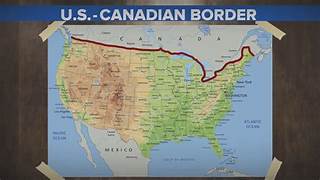n 2002, the United States and Canada shared one of the world's longest international borders, spanning over 5,500 miles. This border, which had historically been relatively open, faced significant changes and challenges in terms of security and immigration following the 9/11 terrorist attacks. The events of September 11, 2001, had a profound impact on the perception of border security in the United States. In response to the attacks, the US government took several measures to strengthen national security, including stricter regulations for border crossings. As a result, the US-Canada border, which had long been known for its ease of travel, faced new restrictions and increased scrutiny. One of the significant changes implemented in 2002 was the Western Hemisphere Travel Initiative (WHTI). This initiative aimed to enhance border security by requiring all travelers, including US and Canadian citizens, to present proper identification when crossing the border. The goal was to prevent potential threats from entering the country and to ensure that individuals crossing the border were who they claimed to be. Prior to the WHTI, US and Canadian citizens could cross the border with minimal identification, such as a driver's license or birth certificate. However, the new regulations mandated the use of more secure identification documents, such as passports or enhanced driver's licenses. The implementation of the WHTI had significant implications for travel and trade between the United States and Canada. Travelers experienced longer wait times at border crossings as officials meticulously checked identification documents. This led to frustrations among individuals who were accustomed to the previously seamless travel experience between the two countries. The increased security measures also had an impact on cross-border trade. The US and Canada had long enjoyed a robust trading relationship, with billions of dollars' worth of goods and services crossing the border each year. However, the new regulations created delays at border crossings, affecting the flow of trade and impacting businesses on both sides of the border. Recognizing the importance of maintaining strong economic ties, the US and Canadian governments worked to address the challenges posed by the new border restrictions. They implemented measures to enhance border infrastructure, increase staffing, and improve technology to expedite the processing of travelers and goods. In addition to the WHTI, other developments in 2002 also influenced the US-Canada border. The creation of the Department of Homeland Security in the United States and the Canada Border Services Agency in Canada signaled a shift in priorities towards border security and immigration control. These agencies were tasked with coordinating efforts to protect the border and ensure the safety of both nations. Over time, the US-Canada border continued to evolve, with new security measures and technologies being implemented. These changes aimed to strike a balance between security and facilitating legitimate travel and trade.
2002 U.S.A. – – US Canada Border
